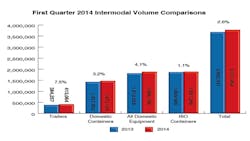Trailer Growth Leads Domestic Container Volumes
Q1 2014 saw total intermodal volumes rise 2.6 percent above the previous year, despite extreme weather conditions depressing economic activity across much of North America, according to the Intermodal Association of North America (IANA). For the first time in nearly a decade, trailer growth outperformed all other intermodal segments, posting a 7.5 percent increase. This ended the domestic container market’s sustained streak of market leadership.
“Severe weather during the first quarter impacted the entire transportation network,” said Joni Casey, president and CEO of IANA. “But despite these challenges, intermodal volumes showed modest growth, led by gains in trailer movements particularly in some of the regions that were hardest hit by winter, such as the Northeast and Eastern Canada.”
Big boxes recorded a 3.2 percent increase over Q1 2013. While the gain was the weakest in four years, it beat many industry market-observers’ expectations, who monitored employment, retail sales and other economic indicators, anticipating a static or declined performance. Domestic containers can still point to an impressive an eight-year cumulative average growth rate of 8.6 percent.
International intermodal volumes demonstrated volatility during Q1 but gained 1.1 percent when compared year-to-year. Declines were recorded in the first two months of the year but international shipments posted an impressive 8.5 percent gain over March 2013. It’s a little too early though to tell whether March is indicative of an upward trend or an anomaly when considering the strength of the international sector.
There were inconsistencies between regional traffic results when comparing quarterly performance. The Northwest, Midwest and Eastern Canada all underperformed the industry average. Conversely, the Mountain Central, South Central, Southwest and Western Canadian regions all performed better than the overall industry average. The Mountain Central region posted a remarkable 17.2 percent growth. However, this region is the smallest intermodal area that is tracked. Western Canada also recorded impressive growth at 8.3 percent over the same time period. Meanwhile, intermodal loads in Eastern Canada declined 1.4 percent despite the percentage of trailer growth and the Northwest saw a 12.9 percent decrease from Q1 2013 to Q1 2014.
Intermodal marketing companies (IMCs), generally a good indicator of broader intermodal industry trends, also felt the effects of adverse weather conditions this quarter. Total volume levels dropped by 1.2 percent year-to-year, marking the first decline since Q3 of 2009. However IMCs reported improved average revenues for Q1, mostly boosted by tighter capacity. Given the long-term strength demonstrated by domestic intermodal coupled with tight trucking capacity, it’s likely that intermodal will continue to be the dominate source of IMC growth for the balance of 2014.

